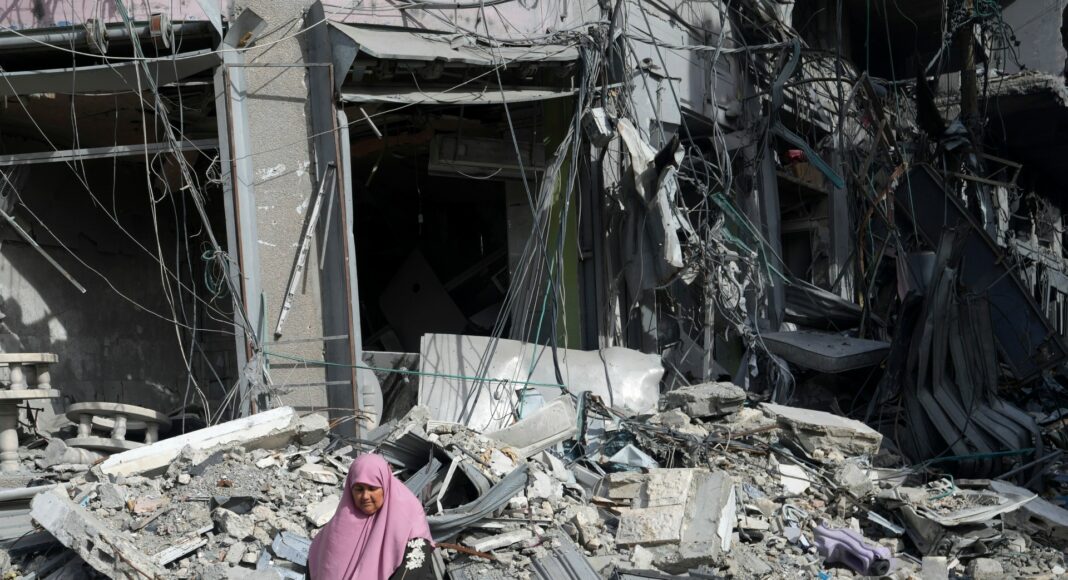The guns indeed fell silent exactly at 7am (05:00 GMT) on Friday. The transition from loud explosions to a sudden calm that the Gaza Strip has not seen in seven weeks was quite eerie.
Right up to the top of the hour, Israeli forces appeared to be taking advantage of every last minute to keep bombing and their Hamas opponents hit back as much as they could.
To everyone’s relief, both sides stopped shooting right on cue. Not a shot was heard as the fighters took a much-needed respite.
All hopes now are that the pause will hold as intended and the ambitious plans for the 96 hours of uneasy truce will be carried out.
A column of Israeli armoured vehicles headed towards Israel, taking soldiers home for short chance to recover. They were not being fired at, so crews stood in open hatches or allowed themselves the luxury of sitting on the vehicles’ steel bodies, basking in the morning sun, obviously trusting the pause and not showing signs of anxiety or fear. Many smiled, demonstrating clear relief, as the plan looked like it was working.
Palestinian fighters also headed outdoors. Many changed into civilian clothes and rushed south to see family members and check who survived the intense bombardment and indiscriminate shelling.
Reporters saw aid agencies not waste a second, the first trucks carrying much-needed supplies crossing the Rafah checkpoint from Egypt minutes after Zero Hour. One hundred crossed into the Gaza Strip on day one, and more are scheduled.
Intricate exchange
The first real test, the late afternoon exchange of 13 Israeli captives held by Hamas for 39 Palestinians imprisoned in Israel, 24 women and 15 teenage boys, also passed smoothly.
Proving how sensitive the affair is, and fully aware of the possibility that a minor glitch could delay or even stop the planned exchanges, the two sides opted not to handle the logistics directly. Instead, they chose the safest approach, using intermediaries and, in the case of Israeli captives, going through an indirect route.
Hamas first handed 13 Israeli captives to the representatives of the International Committee of the Red Cross/Red Crescent (ICRC), who took them across the border into Egypt in a convoy of vehicles, handing them over to Egyptian authorities.
Egyptian “possession” was very brief, as all Israelis were quickly transferred to their country’s secret service, Shin Bet, who flew them by helicopter first to a military base in the Naqab Desert (also called Negev), and then to civilian hospitals where they were reunited with their families.
But this captive release procedure with all its intricacies was not Friday’s first. About half an hour before the liberation of Israeli captives, another group unexpectedly served as proof-of-concept: 10 citizens of Thailand and one Filipino were released, under the same procedures that would be used for the most anticipated group.
The Thai captive deal was apparently negotiated separately, with Egypt as an intermediary. The suddenness with which it surfaced out of complete secrecy proves the nature of the complex negotiations for the release of the captives.
Israel released 39 Palestinian prisoners in a much simpler procedure – no go-betweens or roundabouts: the women and teenagers had first been transferred to Israel’s Ofer prison in the occupied West Bank. At the agreed time, the gates opened, and they were released to their waiting families and then on to East Jerusalem where thousands of Palestinians joined in an impromptu emotional celebration of their return to freedom.
Seeing with different eyes
At the same time, most Israelis were anxiously watching live coverage of the return of the first batch of their compatriots.
An Israeli colleague told me on Saturday that it was only when his family realised how stressed and worried they had been during the seven weeks of collective concern for the captives that they thought of the Palestinians’ anxiety for their own, held for many years. “After this, we may see them with different eyes”, he said.
There was no doubt that both sides were overwhelmed by emotions and some observers hoped that the realisation of how much pain both societies are in might somehow bring them together after the war ends.
But the good news of civilians being set free was marred by less-publicised news of others being killed in spite of the fighting being on pause.
While the two militaries refrained from shooting at each other as agreed, the Israelis demonstrated that, in their mind, the truce extends only to the two armed sides.
Israeli forces confronted hundreds of Palestinian civilians trying to return to their homes in north Gaza during the pause. They were defying Israeli orders to remain in the south, distributed in the media and air-dropped leaflets, and Israeli soldiers fired at them.
Two people killed and 11 wounded by direct, aimed, assault-rifle fire is a sad reminder that, as welcome as it is now, the agreed pause has its definite limits, in duration and in scope and a warning against getting euphoric and too hopeful too soon.



